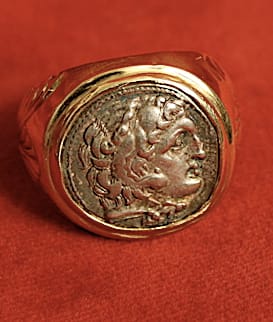Gold Ring with Silver Drachm of King Alexander the Great, 336 BCE - 323 BCE
Silver and Gold
FJ.7141A
Further images
Alexander the Great (Greek: Μέγας Ἀλέξανδρος,[1] Megas Alexandros; July 20 356 BC–June 10, 323 BC), also known as Alexander III, king of Macedon (336–323 BC), was one of the most...
Alexander the Great (Greek: Μέγας Ἀλέξανδρος,[1] Megas Alexandros; July 20 356 BC–June 10, 323 BC), also known as Alexander III, king of Macedon (336–323 BC), was one of the most successful military commanders in history. The name 'Alexander' derives from the Greek words "alexo" (αλέξω, refuge, defense, protection) and "aner" (ανήρ, man). Before his death, he conquered most of the world known to the ancient Greeks. Alexander is also known in the Zoroastrian Middle Persian work Arda Wiraz Nāmag as "the accursed Alexander" due to his conquest of the Persian Empire and the destruction of its capital Persepolis. He is known as Eskandar-e Maqduni (Alexander of Macedonia) in Persian, Al-Iskander Al-Makadoni (Alexander of Macedonia) in Arabic, Alexander Mokdon in Hebrew, and Tre-Qarnayia in Aramaic (the two-horned one, apparently due to an image on coins minted during his rule that seemingly depicted him with the two ram's horns of the Egyptian god Ammon), al-Iskandar al-Akbar الاسكندر الاكبر in Arabic, Sikandar-e-azam in Urdu, Skandar in Pashto. Sikandar, his name in Urdu and Hindi, is also a term used as a synonym for "expert" or "extremely skilled". Following the unification of the multiple city-states of ancient Greece under the rule of his father, Philip II of Macedon (a labour Alexander had to repeat twice because the southern Greeks rebelled after Philip's death), Alexander conquered the Persian Empire, including Anatolia, Syria, Phoenicia, Judea, Gaza, Egypt, Bactria and Mesopotamia and extended the boundaries of his own empire as far as the Punjab. Before his death, Alexander had already made plans to also turn west and conquer Europe. He also wanted to continue his march eastwards in order to find the end of the world, since his boyhood tutor Aristotle told him tales about where the land ends and the Great Outer Sea begins. Alexander integrated foreigners into his army, leading some scholars to credit him with a "policy of fusion." He encouraged marriage between his army and foreigners, and practiced it himself. After twelve years of constant military campaigning, Alexander died, possibly of malaria, West Nile virus, typhoid, viral encephalitis, or the consequences of heavy drinking. His conquests ushered in centuries of Greek settlement and cultural influence over distant areas, a period known as the Hellenistic Age, a combination of Greek and Middle Eastern culture. Alexander himself lived on in the history and myth of both Greek and non-Greek cultures. After his death (and even during his life) his exploits inspired a literary tradition in which he appears as a legendary hero in the tradition of Achilles. More than money, coins are symbols of the state that struck them. Currency represents a specific time and place, whether products of the age we live in today or an artifact of a long forgotten empire. Worth a week’s pay, a silver coin like this would have rewarded the bravery and fortitude of the officers serving under one of history’s most celebrated generals, Alexander the Great. Son to King Phillip II of Macedon, tutored in his youth by Aristotle, Alexander conquered one of the largest empires the world has ever known. Marching from Egypt, through Asia Minor, and into the heart of central Asia, Alexander lead a swift and successful military campaign that defeated the potent Persians and stretched the edges of Hellenic civilization into new lands. While his vast kingdom dissolved after his death, the carefully cultivated legend of Alexander will continue to live on not only in our history books and museums, but also in artifacts like this coin: concrete remnants of ancient kingdoms passed from the hands of civilization to civilization, from generation to generation.
The glories of antiquity shine again with renewed brilliance and luster. Alexander is among the most celebrated and enduring figures of history. The legend surrounding this great figure becomes reality when wearing this ring. The past literally comes alive. This ancient coin is not a relic of the past displayed behind glass in a museum; but mounted in this ring, the coin is a stunning centerpiece appreciated for its age as much as its beauty and superior craftsmanship.
The glories of antiquity shine again with renewed brilliance and luster. Alexander is among the most celebrated and enduring figures of history. The legend surrounding this great figure becomes reality when wearing this ring. The past literally comes alive. This ancient coin is not a relic of the past displayed behind glass in a museum; but mounted in this ring, the coin is a stunning centerpiece appreciated for its age as much as its beauty and superior craftsmanship.





